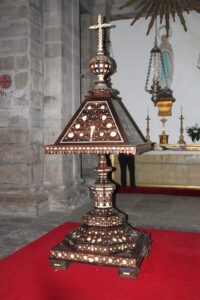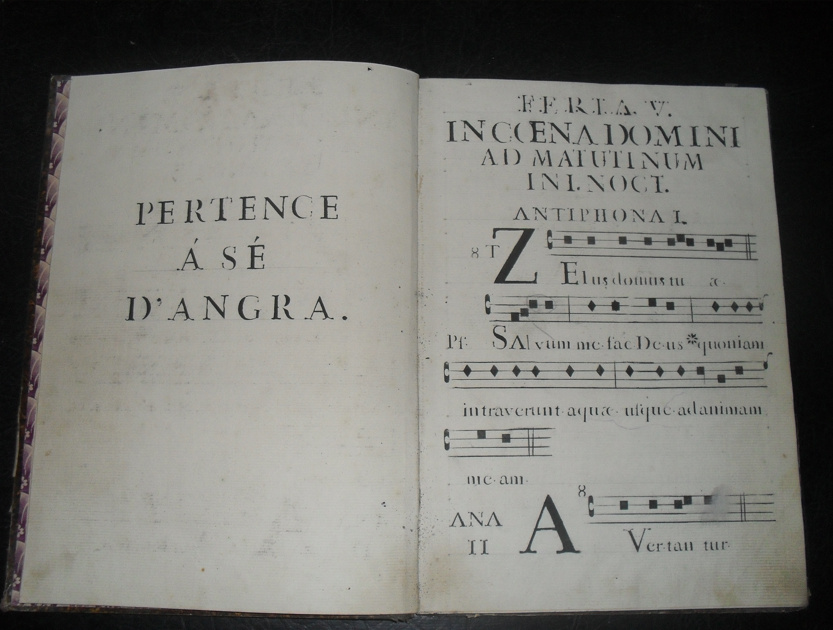
The choir lectern of Angra Cathedral (Terceira Island, Azores)
❧
Lecterns played an important part in the visual culture of musical practice in church choirs throughout the centuries. The stalls have been frequently regarded as the epitome of wood-carving carpentry and embellishment of the choirs but the lectern, usually its centre-piece, frequently stands out as some of the finest art both serving the purpose of holding the heavy choirbooks and, at the same time, as a beautiful object to contemplate. The lectern we now find at Angra Cathedral may be considered as a good example of this and, although it doesn’t serve its original purpose any more, it has a long, varied historical and musical context surrounding it.
The lectern was built for Angra’s Franciscan convent of São Francisco, to be placed at the large choir of its magnificent church dedicated to Nossa Senhora da Guia. Franciscans arrived in the Azores almost at the same time the islands were being discovered by the Portuguese and soon established themselves as the most influential religious order in the archipelago.
The current building of the Convent of São Francisco was the result of an expansion of the initial building which developed from the last decades of the sixteenth century into the following century. It included the construction of three two-story dormitories, the expansion of the cloister, and the building of a new church, this last major project seeing two stages, the last one already in the seventeenth century which gave its actual facade we now see in the Angra landscape (Henriques, 2024, p. 113). The church was consecrated on 1 October 1672 by the Bishop of Angra D. Fr. Lourenço de Castro, following a solemn procession with the presence of members of the town’s administration, military, and numerous clergymen.
A new church meant that there was a need for new instalments both on the altars as well as in the large choir built over the main entrance. A set of stalls were installed to seat the large community of friars for the daily singing of the Hours and major festivities in the convent’s calendar. According to the seventeenth-century Franciscan historian Fr. Agostinho de Monte Alverne, at same point in the house’s history, around sixty friars lived in the convent “that there were people for everything” (Monte Alverne, 1962, p. 25).
It is natural that sometime during the eighteenth century, probably during its first half, an imponent lectern was commissioned to be used at the centre of the church’s large choir by the numerous Franciscan community. The convent was the seat of the Province of São João Evangelista, created soon after the Portuguese Restoration of independence in 1640 thus this piece of furniture seems to have highlighted the power and influence of this community in the remaining houses of the Province.

The lectern is a fine piece of eighteenth-century religious furniture. According to the description made by Francisco Ernesto de Oliveira Martins, the piece is 2,90m high and the base that supports it being 1,03m high. It is made out of Jacaranda wood (Jacaranda mimosifolia) with ivory built-in floral motives and other anthropomorphic figures. It finishes with an ivory cross over a sphere around which the text Ave crux spes vnica can be read (Oliveira, 1996, p. 30).
Local Angra historian Félix José da Costa stated in 1867 that this lectern, by that time already placed in the centre of the Cathedral’s choir, had belonged to the town’s Convent of São Francisco (Costa, 1867, p. 94).
By mid-nineteenth century the lectern was already in use at Angra Cathedral. By the account of Costa (who certainly saw it in the Cathedral) it was used in the centre of the low choir just in front of the main chapel. It was used for its purpose of holding the plainchant books during the Hours offices.
We may speculate on what books might have been in use at the lectern but one that would almost certainly be used was the antiphonary MM 411, a collection of the antiphons for the office of Matins during the Triduum Sacrum. It was copied for use in the Cathedral (as stated in the verso of the first folio, Image 2) in the first decades of the nineteenth century. Although using paper and cardboard guards, the sheer size of its conception suggests that it might have been intended to be used at the lectern, contrasting with other books also made for the Cathedral during this period.

The lectern was moved to the Chapel of St Stephen, on the Gospel side of the church, a large chapel that used to have an imposing altarpiece, that was destroyed in the 1983 that destroyed the Cathedral, and small choir stalls. We assume it might have been moved there soon after 1962 following the implementation of the directives of the Council Vatican II and the end of the celebration of the Latin offices in the choir. The lectern had lost its original purpose remaining, however, as another piece of art furniture.On 1 January 1980 a strong earthquake on Terceira Island severely damaged the Cathedral as well as most of Angra’s and the island’s buildings. This tragic event to the island’s population might have saved this piece from an even tragic end. Due to structural peril, the Cathedral underwent a period of reconstruction with all of its possessions and artwork being moved to storage in warehouses to demolish a bell tower and replacing the ceiling. On the evening of 25 September 1983 a fire consumed the whole building leaving only the walls and burned wood of the interior decoration.After the reconstruction that followed we would find the Franciscan lectern back in the Cathedral, this time placed in the chapel of St Peter ad vincula. It remained there until the end of 2019 when it was again moved back to the chapel of St Stephen, following an exhibition opened there after the placement of the restored large altarpiece painting depicting the Saint’s martyrdom (Henriques, 2019).
BIBLIOGRAPHICAL REFERENCES
Costa, F. (1867). Angra do Heroismo. Ilha Terceira (Açores). (Os seus Titulos, Edificios e Estabelecimentos Públicos). Typ. do Governo Civil.
Henriques, L. (2019, December 18). Exposição “Ecos da Sé de Angra” em Angra do Heroísmo. Glosas online. https://glosas.mpmp.pt/exposicao-ecos-se-angra/
Henriques, L. (2024). Towards the Soundscape of a Developing Azorean Port-Town in the Late Sixteenth Century: Angra (Terceira Island) in the 1590s. In V. S. Matute (ed.). Soundscapes of the Early Modern Hispanophone and Lusophone Worlds. (pp. 107-122). Routledge.
Laranjeira, M. (2008). São Salvador de Angra – uma catedral sebástica. Instituto Açoriano de Cultura.
Monte Alverne, Fr. A. de (1962). Crónicas da Província de S. João Evangelista das Ilhas dos Açores Vol. III. Instituto Cultural de Ponta Delgada, 1962.
Mota V. (2007). Santa Sé do Salvador. Igreja Catedral dos Açores. Sé de Angra do Heroísmo.
Oliveira, A. (Coord.). (1996). Os Descobrimentos e a Arte. Museu Carlos Machado.
Luís Henriques is a PhD in Musicology from the University of Évora and researcher at the University of Évora branch of the Centre for the Study of Sociology and Musical Aesthetics, based at the NOVA-FCSH.

